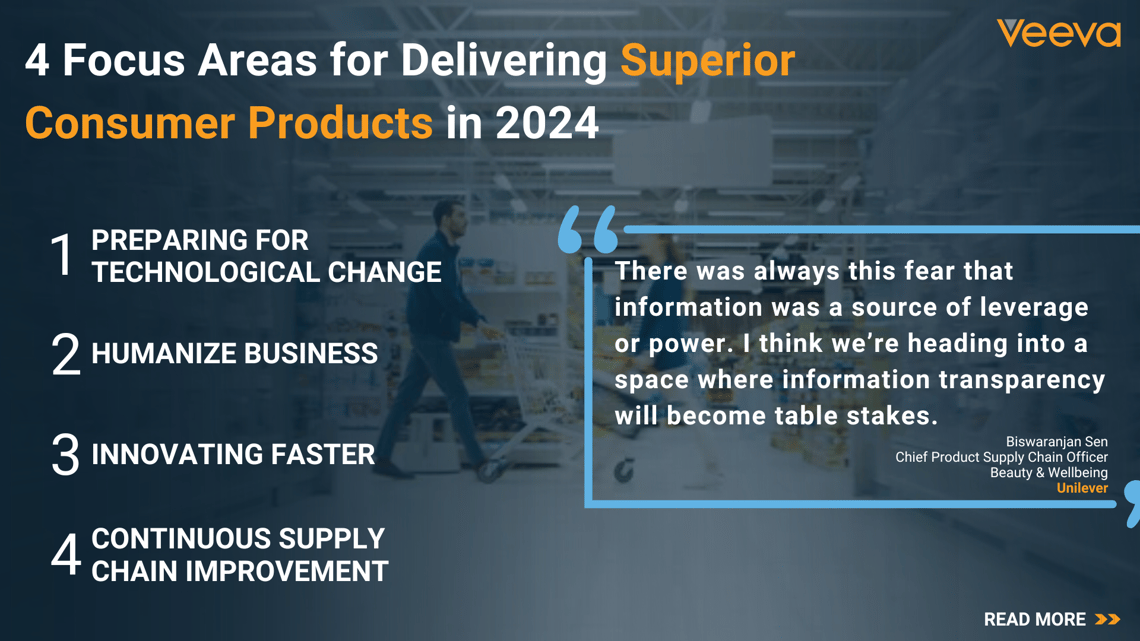The Consumer Packaged Goods (CPG) industry is under pressure from technological and market forces. McKinsey recently reported that post-pandemic, U.S. consumers remain cautious about overspending, and shopper confidence in Europe is also mixed. Economic headwinds mean that CPG market leaders will need to become even more agile and resilient to stay competitive in 2024.
The recent Veeva Executive Summit featured keynotes and a wide range of panel discussions touching on topics important to the CPG industry, from R&D to regulation to supply chain to quality. Leaders noted a number of factors that are having an outsized effect on markets, including:
Social media and e-commerce are enabling trends to spread more rapidly among consumers. Leading CPG companies are leveraging these channels to enter into new conversations with the consumer. “There's this highway of data where hundreds of thousands of consumers are talking about their behavior and their habits,” explained Michael Ott, Chief R&D Officer at The Clorox Company. “Being obsessed with the consumer is really how we bring differentiated products to market.”
The role of digital technology has continued to expand since the pandemic, creating both tremendous opportunities and new perils for CPG companies seeking to gain value from a wealth of data. As Biswaranjan Sen, Chief Product Supply Chain Officer, Beauty & Wellbeing at Unilever, noted, “The problem is not really about the availability of data. It's about the ability to ingest that data at the right frequency and make sense of it.”
The ability to retain workers and attract new talent with the right skills in a tight labor market is being affected by many factors, including generational shifts and technological change.
At the Summit and throughout the year, I make an effort to meet with CPG executives from some of the world's leading companies to better understand everything that goes into the delivery of superior products. My goal in this article is to share some of the insights from these conversations to help you prepare for a successful 2024. I’ll focus on four specific areas:
- Preparing for technological change
- Humanize business
- Innovating faster
- Continuous supply chain improvement
Preparing for technological change
This past year, you heard a lot about emerging technologies like generative AI (GenAI), and you'll be hearing a lot more in 2024 and beyond. While I encourage every CPG company to understand GenAI and related technologies, many companies still have significant groundwork to do before they can begin to take advantage of AI.
In his Summit keynote, Michael Voegele, Chief Digital Officer and Chief Information Officer for Philip Morris International, explained, “You need to do your data management, you need to do your data classification, you need to manage your data quality, and you need to figure out how you secure all of this data. Without that, just moving into GenAI is not going to work.”
The first step in successful transformation is often taking a hard look at where and how your data is stored. Breaking down data silos helps facilitate deep analysis to identify patterns faster. By structuring and standardizing your data, you gain the insights necessary to drive innovation.
When thinking about how your organization can take advantage of AI, Voegele suggests that, once a strong foundation is in place, it’s really a two-part approach. The first part comes “for free,” as your existing software vendors incorporate AI capabilities.
“The second piece, which I think is more complicated, is ‘how do I utilize large language models in a safe environment?’ I don't want to expose my IP through public models like ChatGPT,” Voegele explained. “We’re still in very early stages. We’ve taken an approach that’s about ‘try and learn.’ I have yet to see a company where they took a large language model, put it into practice at scale, and have seen benefits to the top or bottom line.”
It’s essential to focus on business value. “I truly believe we have to think about technology as an enabler,” said Voegele. “But we also have to see that technology only creates value if we change how we operate, how we work, and re-envision the way we actually bring our products to market.”
Humanize business
Your business strategy is only as good as your ability to communicate it to your organization. It all comes down to having clear goals: How can you leverage your team to achieve your business strategy? How can you retain the workers you have? And how can you attract the best talent in a tight labor market?
Here are three things to keep in mind that are certain to resonate in 2024:
Learning vs. knowledge – With everything seemingly changing faster, possessing specific knowledge has become less important. The Internet–and now GenAI–makes it easy to find answers. How well someone can learn and synthesize new information has become more critical. “When I joined the workforce, I was hired for my skills,” noted Sen. “But now it’s about what I can learn.”
Flexibility – In the post-pandemic world, professional workers are accustomed to the flexibility that comes with remote or hybrid work. Job flexibility is now an important element of job satisfaction for everyone. “Our frontline wants flexibility as much as our professional workforce,” explained Rosa Santos, Vice President, Human Resources Talent Management & Organizational Development at PepsiCo. “We've been implementing a lot of creative ways of affording flexibility and predictability of scheduling for our frontline workforce.”
Experiences – Today’s workers, especially younger workers, want a broader range of “experiences” on the job. Campbell Soup Company has adapted ideas from the gig economy to meet this need. “We built a whole program where folks can stay in their current job, but they can do a different gig job for three to six months,” explained Craig Slavtcheff, Chief R&D and Innovation Officer at Campbell’s. “It’s a great way to build bench strength in the organization. We had folks from supply chain want to get in on the gig action and then finance. Now we have a gig posting website.”
Focusing on these three areas will help you retain the employees you have and attract the talent you need to keep moving forward.
Innovating faster
There’s a lot of pressure on global CPG companies to deliver differentiated products that are superior to the competition. “In food and CPG, where prices have been driven up by commodities and inflation across the board, we still feel that there will be a strong role for premium brands and premium businesses,” noted Slavtcheff. “But, if you're going to be offering something premium, it's got to be worth a premium. It's got to blow your socks off.”
Innovation is more important than ever for companies that want to maintain a pipeline of unique, new products. industry leaders are succeeding with these three strategies:
Consumer-led innovation – Companies need to do everything possible to get closer to their consumers. For example, Estée Lauder stays in touch with its consumers through multiple touch points in addition to conventional consumer needs gap analysis. Bhasin noted some important questions that CPG companies should seek the answers to: “How are consumers operating in the virtual world? And how are they interacting with the products on social media? We see a lot of unarticulated learnings coming out of that.”
Democratizing data – A good idea can come from anywhere, so it’s crucial that stakeholders have access to data to investigate trends and make informed decisions. “The power of digitizing your workflows is that you can make them accessible to everyone,” said Slavtcheff. “It creates a much more inclusive environment for folks to find their voice as part of the innovation process.”
“We're looking at predictive analytics so every developer can have it at their desktop,” explained Bhasin. “We’re making data much more accessible to the formulator as well as the consumer researcher.”
Shrinking the path to production – Leading companies are using digital technology to reduce the time it takes to go from an idea to a product coming off the line. Modeling and simulation–including digital twins of proposed production lines–can increase speed and accuracy.
Organizations like The Clorox Company are also pivoting to a “fail fast” mentality for innovation: “A quick capability, forming a small group and if it works out, we'll build it from there,” explains Ott. “The newer employees are very adaptable, very robust, and willing to try things quickly. And if it doesn't work, move on to the next thing.”
My recent blog, Consumer-Led Product Innovation in a Digital World, explores these topics further.
Continuous supply chain improvement
Over the past year, CPG leaders reflected on all of the supply chain disruption caused by the pandemic and resolved to do better.
“What the pandemic brought home was how exposed elongated supply chains are,” said Sen. “Ten years ago, it was okay to have stuff coming out of China or Vietnam with a four-week lead time because lead times were predictable. The volatility has exposed the fragility of elongated supply chains, requiring a set of network resets–nearshoring, proximate sourcing, etc.”
“When it comes to the supply chain, three main topics emerged,” explained Marcelo Lu, Senior Vice President, Care Chemicals at BASF. “One was resilience. Another was knowledge or information. And the last was trust in the system. We had to implement measures to regionalize a lot of our supply chain and create business continuity plans for a lot of our customers. On the knowledge side, you need to get data very quickly–so digitize a lot more. And I think the trust component is really on the relationship level, being able to connect beyond our immediate customer because we’re in the middle of the value chain.”
“It's the shift from ‘just in time’ to ‘just in case,’ added Sen. “And how much do you want to invest in that, because it doesn't come free. Then how do you connect in real time to what's happening in the frontend and in the backend?”
Transparency has become a key concept in today’s supply chain. In the past, vendors, suppliers, and retailers held onto information too tightly. “There was always this fear that information was a source of leverage or power. I think we’re heading into a space where information transparency will become table stakes,” Sen observed. “Without that, it will be impossible to run an efficient value chain end to end. The more seamless that information flow becomes, the higher the value unlocks will be.”

Insights for action
Here are four focus areas for CPG companies as 2024 begins:
- Keep a close eye on the new capabilities that emerging technologies like GenAI will unlock. It’s important not to get left behind.
- To attract and retain workers, create a work environment that gives both professional and frontline employees the flexibility they need and the experiences they want.
- Accelerate innovation by finding ways to get closer to the consumer, democratizing access to data across your organization, and using digital tools to bring new products to market faster.
- Focus on building more resilient and transparent supply chains. Regionalizing elongated supply chains reduces risk and digitizing processes accelerates the flow of information.
Learn more about how Veeva is helping CPG companies innovate faster and differentiate. And watch the Executive Summit panel sessions on-demand to gain additional insights from your industry peers.

SHARE






